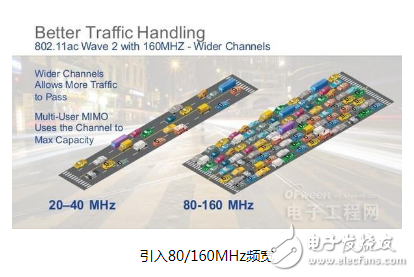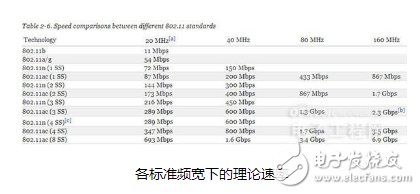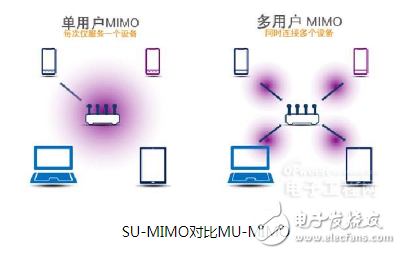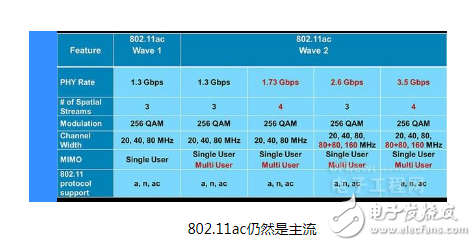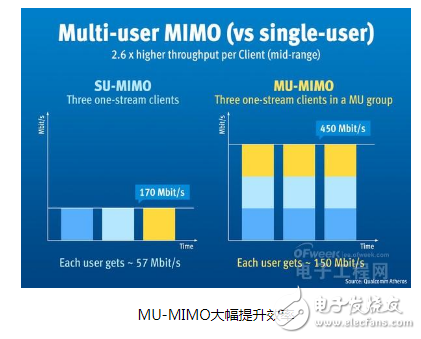WiFi has become an indispensable network connection method for us. Whenever we go to a certain place, we will look for WiFi hotspots all around. Like the mobile network we use, WiFi has also improved from the 3G-4G-5G era. Nowadays, home routers have basically entered the 802.11ac stage. Whether it is a home router of a few hundred yuan or thousands of high-end routers, 802.11ac has basically become a standard configuration. 802.11ac is now adopted by mainstream routers, but most home routers are still in the stage of the first generation of 802.11ac, and the second generation of 802.11ac products have been on the market since last year. 802.11ac Wave 1 and 802.11ac Wave 2 can be understood as two generations of products. Because Wave 2 has just started, there are still few products on the market for the time being. WiFi has experienced the development of 802.11a/b/n/ac, and the bandwidth rate has been improved. Although both are 802.11ac, it has evolved from "802.11ac Wave 1" to "802.11ac Wave 2", and with the addition of multiple technologies, WiFi is faster and better. Next, we will talk in detail about how awesome the development of WiFi is today. Mainstream 802.11ac has three major characteristics First of all, let’s talk about the characteristics of 802.11ac. Compared with the 802.11n standard, the 802.11ac standard mainly introduces 256-QAM modulation mode, 80/160MHz bandwidth and MU-MIMO technology, which is used in single link speed and bandwidth utilization. There is a big increase in the rate. 802.11ac uses 256-QAM modulation mode. Compared with the 802.11n standard, it uses 64-QAM, while 802.11ac uses 256-QAM. The higher the level of QAM, the more data the signal can contain each time. The picture we found shows that every point is a data packet. Compared with 64-QAM, 256-QAM has a higher density of data packets, and the amount of data that can be transmitted in the same unit time will be more. Of course, the higher the QAM level, the error code rate is likely to occur, but even so, the standard theoretical network speed of 802.11ac is higher than that of 802.11n. The second is that 802.11ac introduces 80/160MHz bandwidth, which doubles the theoretical network speed. Under the premise of single link link, the theoretical rate of 802.1ac network with 80MHz bandwidth can reach 433Mbps, which is equal to the theoretical rate of 40MHz 802.11n network with 3x3 MIMO. Therefore, under 80/160MHz bandwidth, increase With 256-QAM, the network rate of 802.11ac has increased significantly. After working hard on the modulation and demodulation method and the use of frequency bands, there is another way to improve the efficiency of data exchange between routers and terminals. MU-MIMO is a technology used to improve the utilization of 802.11ac network bandwidth. Most of our traditional routers use conventional MIMO (Multiple-Input MulTIple-Output), which we call SU- MIMO (Single User), single user has multiple inputs and outputs. Although it can transmit at the same time through multiple links to increase the network speed between the router and the terminal, the router can only communicate with a single terminal at the same time and in the same frequency band. This means that even if the terminal does not completely occupy all the bandwidth, the router cannot allocate the remaining bandwidth to other devices at the same time. The emergence of MU-MIMO (MulTIple User) is to solve this problem, adding a multi-user simultaneous communication mode on the basis of conventional MIMO, so that all wireless bandwidth can be fully utilized. If you have only 4 terminals at home, there may not be a noticeable delay, but if you have 10 or more terminals connected to the Internet, Wi-Fi will become congested, which means that the buffer waiting time will be limited. It will be very long, and the network video cannot be played smoothly. With the increase in the number of smart terminals owned by individuals in the family, it is obvious that many people will not only have 4 networked terminals in their homes. With MU-MIMO, the efficiency of the connection will be greatly improved. It can be used in public places. In the case of simultaneous multi-user access, the communication delay can be reduced, and MU-MIMO does not require user settings. As long as the terminal and router support MU-MIMO technology, the connection between the two will be naturally used. These technologies make WiFi faster and more efficient 802.11ac will still be the mainstream in the next few years. 802.11ad works in the high frequency of 60GHz and is mainly used for wireless high-speed transmission in indoor environments. 802.11ax (the next-generation WiFi standard) is still under development. Related technical details Still discussing. As mentioned earlier, 802.11ac Wave 1 products are still the mainstream in the market, but Wave 2 products have been launched one after another, and it will obviously become the first choice for purchase. Now Qualcomm and other manufacturers have launched related chip solutions for Wave 2, adding MU-MIMO (multi-user multiple input multiple output) technology, supporting 160MHz channels and 4x4 antenna configurations, and also adding tri-band (2.4GHz and two 5GHz band) technology. Take Qualcomm as an example. They have launched QCA9984 for home routers and QCA9994 for enterprise access points. Many manufacturers such as TP-Link have indicated that they will adopt Qualcomm's Wave 2 chip solution. The Wave 1 solution adds two characteristics of 256-QAM modulation and demodulation mode and 80MHz frequency band. The remaining technical indicators are the same as those of mainstream home 802.11n routers at the time. For example, MIMO still uses SU-MIMO and the highest 3x3 MIMO array, so 802.11 The ac router is only a lot better than 802.11n in the case of a single link. Wave 2 has joined the MU-MIMO technology, and compared to the 3x3 MIMO array used by Wave 1, it can be increased to 4x4 MIMO, the antenna array is more advanced, and the theoretical network rate of a single frequency band has reached 1766Mbps. Regarding the use of 160MHz bandwidth, why we rarely see 802.11ac routers in our homes. On the one hand, although the 160MHz bandwidth can greatly increase the network speed, the anti-interference ability of this continuous bandwidth is weaker than that of 80MHz; on the other hand, The corresponding terminal is required to provide support. Under comprehensive consideration, the market environment is not applicable. In order to solve this problem, Qualcomm’s new solution has now been able to support more flexible configuration methods, supporting the new and wider 160MHz continuous channel configuration and 80+80MHz non-contiguous channel configuration 802.11ac standard, and the existing 80MHz channel capacity Doubled, while improving anti-interference ability. Now our router products are basically dual-band support, that is, 2.4GHz and 5GHz, and now 802.11ac already has a three-band solution, that is to add an additional 5GHz frequency band on the original basis. The role of tri-band WiFi is actually similar to that of MU-MIMO. It also improves the efficiency of connection communication and better improves bandwidth utilization. If the device does not have MU-MIMO technology, the router can communicate with two devices at the same time in its 5GHz frequency band. In fact, its purpose is to solve such as a family, when there are multiple routers for relaying and connecting, a 5GHz frequency band is connected to a relay router for a long time, which occupies all the bandwidth of this 5GHz frequency band. In this case, the rest 2.4 GHz and another 5GHz band can still work without causing interference. It should be pointed out that MU-MIMO support can be added to each frequency band, which means that it has no effect on the efficiency of the router. MU-MIMO is of great help to the improvement of WiFi efficiency. The wider 80/160MHz can increase the bandwidth, and the 4x4 antenna configuration and the addition of tri-band technology are good for obtaining better signals and improving anti-interference ability. . It's easy to use besides being fast The technology mentioned above is to improve the network capacity and speed of WiFi, but with the advent of the Internet of Things era, WiFi routers will appear in a combination, which means that there will not be only one router in our homes, businesses, and companies. And we are increasingly inseparable from WiFi. Whether it is your parents or your children, they may often encounter obstacles in how to set up a WiFi network. At the same time, the connection of multiple routers and the setting of relays will also increase the difficulty of configuration. In response to this phenomenon, Qualcomm has made WiFi network installation smarter, safer and fully automated through Qualcomm Wi-Fi SON technology. WiFi Son technology has four characteristics: self-configuration, self-management, self-repair and self-defense. In terms of self-configuration, the fact is to let the phone automatically find WiFi hotspots, and the phone will automatically pop up a dialog box indicating whether it needs to be connected; self-management means that the device terminal can automatically detect the 2.4GHz and 5GHz signal strength, bandwidth occupation and other indicators, according to The best choice principle is to connect to 2.4GHz or 5GHz. If you are very close to the router, the network throughput of the 5GHz frequency band will be relatively large, and the phone will automatically select the connection, but when you are far away from the router, the quality of the 5GHz frequency band becomes very poor, it will automatically select it and automatically switch to 2.4GHz On the frequency band, this process is seamless, and consumers will not perceive it. Self-repair means that in the case of many WiFi hotspots in public places, if you are connected to a hotspot that cannot be connected to the Internet, the system will automatically repair it and automatically find other hotspots that can be connected to the entire network. When the original hotspot is back online, it will automatically reconnect. Finally, self-defense means that under the Internet of Things, various devices, such as light bulbs and door locks, have the ability to link, but they cannot protect their own safety. WiFi Son can provide these terminals with the ability to protect and learn. For example, when you go home when you go home, the light bulb will automatically turn on to learn and adapt to the user's behavior. With WiFi Son, the automatic configuration feature makes it easier to load and configure new terminals (including Bluetooth terminals) in the WiFi network, which includes self-management features. LTE and WiFi are smarter The relationship between LTE and WiFi is very close, and some wireless technologies can improve user experience. Qualcomm's low-power hotspot function and LTE and WiFi antenna sharing are more interesting and practical technologies in the near field. Under normal circumstances, hotspot data sharing needs to wake up the processor to exchange data between LTE and WiFi. Low-power hotspot technology is to reduce the wake-up step. LTE and WiFi directly exchange data to reduce power consumption. Antenna sharing is called Antenna sharing, which enables WiFi and LTE to share antennas. Because the antenna design is becoming more and more complex now, the antenna that can be accommodated by the terminal equipment we have is extremely limited. Using antenna sharing technology, when LTE does not use a certain antenna, WiFi can use the idle antenna. In general, our mobile devices now basically have 2X2 or 4X4 antenna designs. If we use antenna sharing technology, we don’t need to design antennas specifically for WiFi connections, just share the LTE connection antenna. Because some of the frequency bands used by LTE are close to those used by WiFi, it will be much easier for them to share antennas. to sum up We are more and more inseparable from WiFi, and it is constantly being upgraded and changed. After the WiFi standard iteration of 802.11a/b/n/ac, although the current mainstream 802.11ac standard remains unchanged, it adopts various functions and technologies such as MU-MIMO, tri-band WiFi, 80/160MHz, 256-QAM, etc. 802.11ac network capacity and connection rate are constantly expanding and improving. In the European and American markets, 80% of routers currently use MU-MIMO technology, but there is a lot of room for development in the Asian market. Because in Asia, whether it is China, India or Southeast Asia, many people have multiple mobile phones, which shows that MU-MIMO is very important to the Asian market. WiFi is also becoming faster, allowing networked terminals to have more flexible, easier-to-use, and more seamless ways of networking.
Battery Connector:Cell phone battery connector Net bookbattery Connector ,Cell Phone Battery Connector.
Power connector, which includes an insulating body and a plurality of terminals, the insulating body has a plurality of holding slots which hold the terminals, the insulating body is additionally provided with at least one tongue piece which isolates the terminals, the terminals are respectively provided with a barb, the terminals are respectively extended outwards on the first side of the barbs with a plurality of contact parts, and the second barb A plurality of wires are fixed at the side; through the above structure, the barb of the terminal can be embedded in the insulation body, and the terminal is easy to assemble, and only needs to be pushed into the insulation body, and there is no short circuit equivalent energy between the terminals.
Battery Connector ShenZhen Antenk Electronics Co,Ltd , https://www.antenkwire.com
